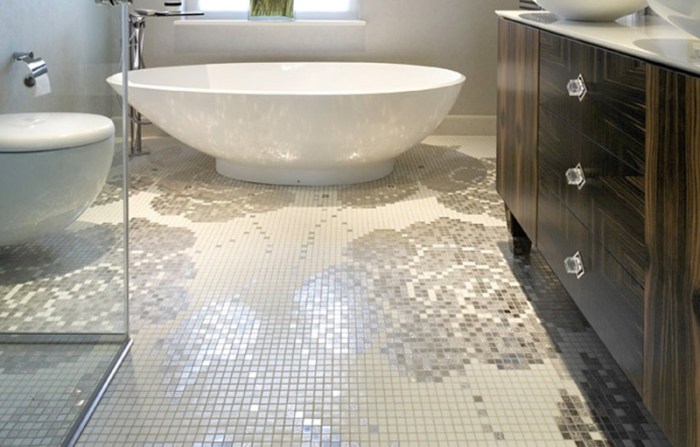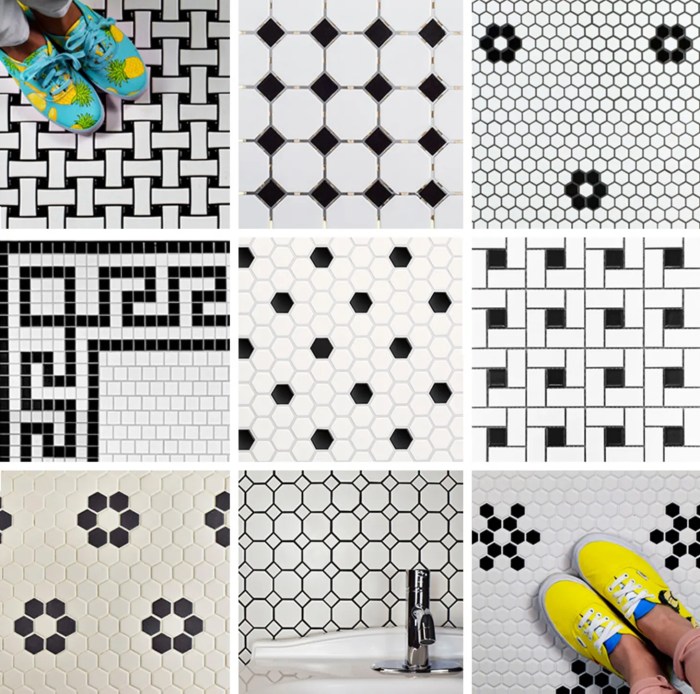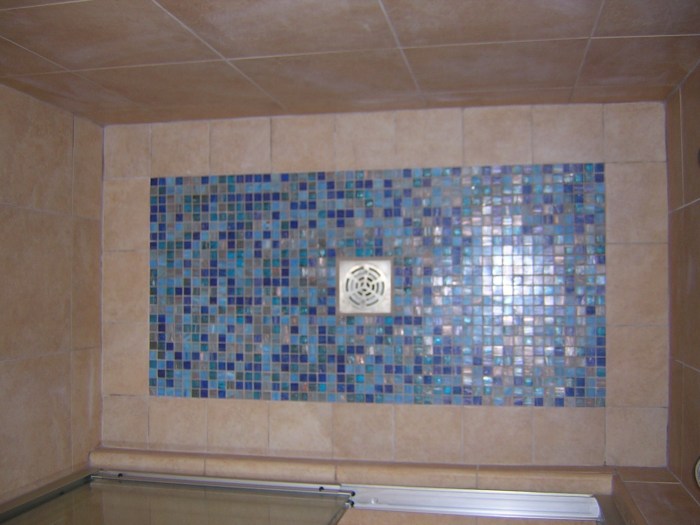Stepping into a bathroom adorned with custom mosaic tile patterns is like embarking on a captivating visual journey. These intricate designs transform ordinary floors into breathtaking masterpieces, adding a touch of artistry and exclusivity to your personal sanctuary.
From vibrant hues to geometric shapes and shimmering textures, custom mosaic tiles offer endless possibilities for personalization. Unleash your creativity and let your bathroom floor become a canvas for your unique style and vision.
Design Elements
Custom mosaic tile patterns for bathroom floors offer a captivating and unique aesthetic appeal that sets them apart from ordinary tiling options. By combining different colors, shapes, and textures, homeowners can create visually stunning floors that reflect their personal style and enhance the overall ambiance of their bathrooms.
The versatility of mosaic tiles allows for endless design possibilities. From classic geometric patterns to intricate organic motifs, there’s a mosaic design to suit every taste and bathroom decor. The use of vibrant colors can create a cheerful and energizing atmosphere, while neutral tones provide a more sophisticated and timeless look.
Colors and Shapes
The choice of colors and shapes for mosaic tiles can significantly impact the visual impact of the floor. Bold and contrasting colors, such as black and white or blue and yellow, create a striking and dramatic effect. Pastel shades and earthy tones, on the other hand, evoke a sense of tranquility and serenity.
Similarly, the shape of the tiles can influence the overall design. Square tiles create a clean and modern look, while hexagonal tiles add a touch of whimsy and movement. Round or oval tiles can soften the appearance of the floor and create a more organic feel.
Textures and Patterns
Textures and patterns can add depth and interest to mosaic tile floors. Textured tiles, such as those with a matte or glazed finish, create a tactile experience and can enhance the visual appeal of the design. Patterns, such as herringbone or chevron, can add visual movement and create a dynamic effect.
By combining different colors, shapes, and textures, homeowners can create custom mosaic tile patterns that are both visually appealing and functional. These unique and eye-catching floors can transform a bathroom into a stylish and inviting space.
Material Considerations
The choice of materials for custom mosaic tiles significantly influences the durability, longevity, and aesthetic appeal of the finished product. Each material offers unique advantages and disadvantages, and it’s essential to carefully consider these factors before making a selection.
Ceramic tiles are a popular choice for bathroom floors due to their durability, affordability, and wide range of colors and patterns. They are made from clay that is fired at high temperatures, making them resistant to moisture and wear. However, ceramic tiles can be susceptible to chipping and cracking if not installed or maintained properly.
Glass Tiles
- Pros: Glass tiles are known for their vibrant colors, glossy finish, and ability to create stunning mosaics. They are also resistant to moisture and stains, making them ideal for bathrooms.
- Cons: Glass tiles are more expensive than ceramic tiles and can be more challenging to install. They are also more prone to scratching and breakage than other materials.
Stone Tiles
- Pros: Stone tiles, such as marble, granite, and slate, offer a natural and luxurious look. They are highly durable and resistant to wear and tear. Stone tiles can also be honed or polished to create different finishes.
- Cons: Stone tiles are more expensive than ceramic or glass tiles and can be difficult to cut and install. They also require regular sealing to protect them from stains and moisture.
Metal Tiles
- Pros: Metal tiles, such as stainless steel or copper, provide a modern and industrial look. They are highly durable and resistant to moisture and corrosion. Metal tiles can also be easily cut and installed.
- Cons: Metal tiles can be more expensive than other materials and may require special cleaning and maintenance to prevent tarnishing.
When selecting the material for your custom mosaic tile bathroom floor, consider the desired aesthetic, durability, budget, and maintenance requirements. By carefully weighing these factors, you can choose the material that best suits your needs and preferences.
Installation Techniques
Installing custom mosaic tile patterns demands meticulous preparation, precise layout, and expert grouting techniques to achieve a professional-looking finish. This section will guide you through the intricate process, addressing common challenges and providing practical solutions for a seamless installation.
Before embarking on the installation, thorough preparation is crucial. Ensure the subfloor is level, smooth, and free of debris. Mark the layout of the mosaic pattern using a chalk line or laser level to ensure accuracy. Transfer the pattern onto the subfloor using a notched trowel to apply a thin layer of mortar or adhesive.
Setting the Tiles
Gently press the mosaic tiles into the mortar or adhesive, ensuring they are level and firmly seated. Use spacers to maintain consistent grout lines. Allow the adhesive to set for the recommended time before proceeding to the next step.
Grouting
Grouting is a critical step that seals the joints between the tiles and enhances the overall aesthetics. Mix the grout according to the manufacturer’s instructions and apply it using a grout float or sponge. Work the grout into the joints, removing any excess.
Allow the grout to dry and cure completely before cleaning the surface with a damp sponge.
Finishing Touches
Once the grout has cured, seal the tiles and grout lines using a penetrating sealer. This will protect the surface from moisture and stains. Allow the sealer to dry completely before using the bathroom.
Design Inspiration
To inspire your custom mosaic tile pattern, explore a global gallery of captivating designs. From ancient Roman mosaics to modern masterpieces, each example showcases unique design principles and techniques.
These patterns demonstrate the power of color, shape, texture, and scale to create visually stunning effects. They offer insights into how to incorporate personal style and preferences into your own mosaic designs.
Design Principles and Techniques
- Color Theory: Explore color harmonies, contrasts, and gradients to create vibrant and cohesive patterns.
- Shape and Form: Experiment with geometric shapes, organic forms, and asymmetrical compositions to achieve visual interest and movement.
- Texture and Dimension: Introduce depth and texture by using tiles with varying surfaces, glazes, and finishes.
- Scale and Proportion: Consider the size and scale of tiles relative to the overall space to create a balanced and harmonious design.
- Composition and Flow: Arrange tiles in a way that guides the eye and creates a sense of rhythm and flow.
Incorporating Personal Style
To create a truly unique mosaic, incorporate elements that reflect your personal style and preferences:
- Color Palette: Choose colors that resonate with your taste and complement your bathroom’s décor.
- Pattern and Motif: Select patterns and motifs that align with your aesthetic sensibilities, whether they be geometric, floral, or abstract.
- Texture and Finish: Opt for tiles with textures and finishes that evoke the desired ambiance, from sleek and glossy to rustic and textured.
- Custom Artwork: Consider incorporating custom artwork or personal touches into your design, such as a monogram or a favorite quote.
Cost and Value
Custom mosaic tile patterns for bathroom floors can vary in cost depending on several factors, including the complexity of the design, the materials used, and the size of the area being tiled. However, the investment in a custom mosaic tile floor can provide significant return on investment and add value to your bathroom.
The cost of custom mosaic tile patterns is typically higher than that of standard tiles, but the unique and personalized look they create can add significant value to your home. Mosaic tiles are also very durable and easy to clean, making them a great choice for busy bathrooms.
Budgeting Tips
To help you budget for your custom mosaic tile project, here are a few tips:
- Start by determining the size of the area you want to tile.
- Choose a design that fits your budget and style.
- Get quotes from several different contractors.
- Consider doing some of the work yourself to save money.
DIY vs. Professional Installation
DIY installation can be a rewarding experience, offering cost savings and the satisfaction of creating a unique bathroom space. However, professional installation ensures a higher quality result, especially for complex patterns or large-scale projects.
DIY Installation
DIY installation is suitable for those with some tiling experience and a willingness to invest time and effort. It allows for customization and control over the project timeline. Essential tools include a notched trowel, tile cutter, spacers, and a level.
Professional Installation
Hiring a professional installer is recommended for intricate designs, large floor areas, or when precision and durability are paramount. Professionals have the expertise, tools, and experience to handle challenging installations and ensure a flawless finish.
When to Consider Hiring a Professional
Consider professional installation if:
- The pattern is highly complex or requires precise cuts.
- The floor area is large or has irregular shapes.
- The tiles are expensive or fragile.
- You lack the necessary tools or experience.
Tips for Successful DIY Installations
- Plan carefully and measure accurately.
- Use high-quality materials and tools.
- Practice cutting tiles before starting the actual installation.
- Use spacers to ensure even spacing between tiles.
- Allow the thinset to dry completely before grouting.
- Seal the grout to protect it from moisture and stains.
Maintenance and Repair
Custom mosaic tile floors require regular maintenance to preserve their beauty and longevity. Proper care includes cleaning, sealing, and repairing tiles to address common issues like grout stains, efflorescence, and loose tiles.
Regular cleaning with a mild detergent and water helps remove dirt and debris. Sealing the tiles with a penetrating sealer every few years protects them from moisture and stains. For deeper cleaning, use a tile cleaner specifically designed for mosaic tiles.
Grout Maintenance
Grout, the material that fills the joints between tiles, can become stained or discolored over time. To clean grout, use a grout cleaner or a mixture of baking soda and water. For stubborn stains, apply a hydrogen peroxide solution. Rinse thoroughly after cleaning.
Repairing Loose Tiles
Loose tiles can be repaired using a thin-set adhesive. Remove the loose tile, clean the surface, and apply a thin layer of adhesive. Press the tile back into place and let it dry overnight. Grout the joint between the tile and its neighbors.
Addressing Efflorescence
Efflorescence is a white, powdery substance that can appear on the surface of tiles. It is caused by the migration of salts to the surface. To remove efflorescence, use a vinegar solution or a commercial efflorescence remover. Rinse thoroughly after cleaning.
Last Recap
Incorporating custom mosaic tile patterns into your bathroom floor not only enhances its aesthetics but also adds value to your home. With proper maintenance, these durable and visually stunning tiles will endure the test of time, providing years of enjoyment and admiration.



